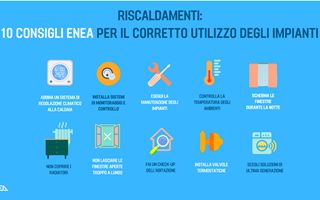(Finance) – Boilers and radiators will start up again starting next week with the switching on of the systems in band E which includes many large cities in Northern Italy, such as Milan, Turin, Bologna and Venice. To combine comfort and savings, from AENEAS they arrive indications on the correct use of heating systems.
First tip: pay attention to the water delivery temperature. Generally – explains ENEA – the home heating time slots are programmed with a chronothermostat, which however only allows you to set the temperature inside the home and not the temperature of the water flow into the radiators which remains pre-set and fixed. “With variations in the external temperature of up to ten degrees on a daily basis, it is necessary to avoid always sending water at the same temperature to the radiators. The ideal solution is to combine climate thermoregulation with the heating boiler”, he explains Nicolandrea Calabrese, head of the ENEA Energy Efficiency Laboratory in buildings and urban development. There climatic thermoregulation allows the regulation of the delivery temperature of the heating system according to external climatic conditions, maintaining the desired room temperature and limiting consumption. In practice, the lower the external temperature, the higher the delivery temperature to the radiators or radiant floor. “This type of thermoregulation is essential both for condensing boilers, which work at low temperatures, but also for heat pumps, always keeping in mind that for each additional degree required we spend 2.5% more energy. Seen that the flow can vary by up to 10° C, we can limit consumption by up to 25%!”, he concludes Calabrian.
ENEA’S TEN COUNCILS
Combine the heating boiler with a climate regulation system – Climatic thermoregulation intervenes through a “sliding” regulation on the delivery temperature of the water to the heating system according to the external climatic conditions, allowing the desired room temperature to be maintained and limiting consumption by up to 25% every 10° C less.
Install monitoring and control systems – Monitoring energy consumption through smart meters is essential to gain awareness of one’s consumption habits and to promptly identify any losses or malfunctions.
Perform plant maintenance – A system consumes and pollutes less when it is correctly regulated, clean and without limescale encrustations. For those who do not carry out maintenance on their system, a fine starting from 500 euros is foreseen (Presidential Decree 74/2013).
Check the temperature of the rooms and pay attention to the switch-on times – First of all, it is necessary to determine which of the 6 climate zones into which Italy is divided you are: in fact, the maximum number of hours of switching on varies, by law, based on the climate zone. 19°C is enough to guarantee the necessary comfort. For every degree less you save up to 10% on fuel consumption.
Screen windows at night – Shutters and shutters or even heavy curtains reduce heat loss towards the outside.
Do not cover radiators – Avoid placing screens in front of radiators, such as curtains or furniture, which hinder the diffusion of heat into the room. However, it is good to insert reflective materials between the wall and the radiator: even a simple sheet of tinfoil helps to reduce dispersion towards the outside.
Don’t leave windows open for too long – Renewing the air in a room takes just a few minutes, while leaving the windows open for too long leads to unnecessary heat loss.
Do a home check-up – Choose a qualified technician to evaluate the efficiency of the heating system and the state of the thermal insulation of walls and windows. It is possible to reduce consumption by up to 40%.
Install thermostatic valves – Mandatory by law in condominiums, thermostatic valves allow you to reduce consumption by up to 20%.
Choose latest generation solutions – Replace the old system with a high-efficiency condensation or heat pump system and adopt chronothermostats, presence sensors and remote electronic regulators.
